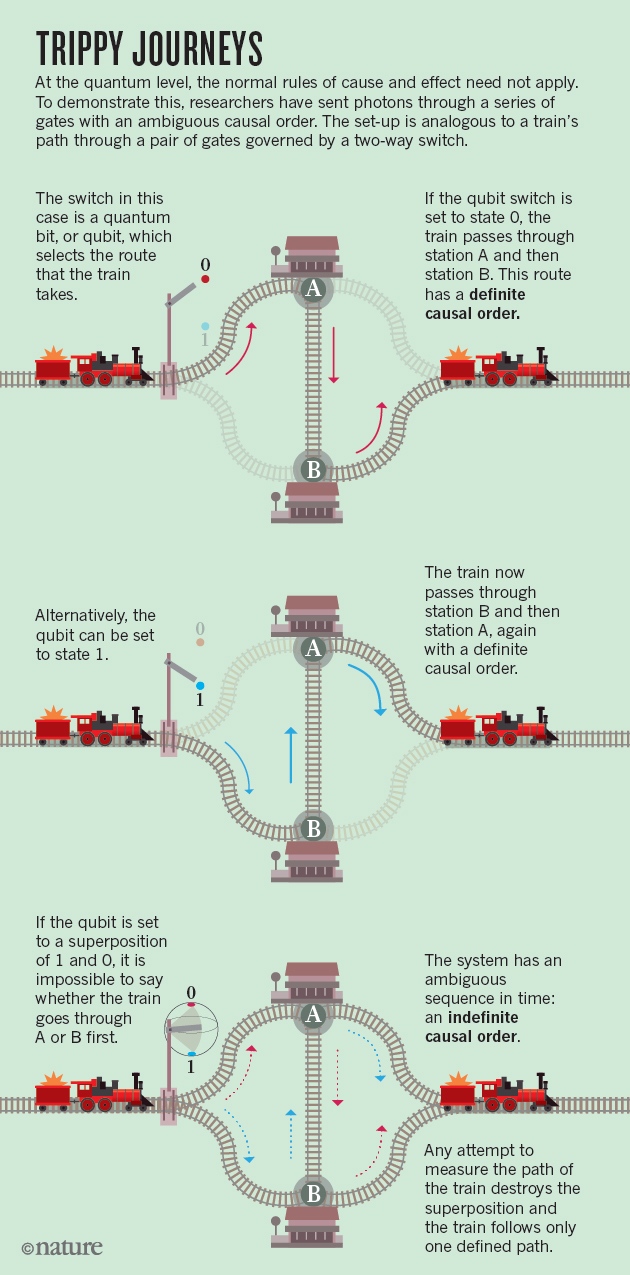eot
Banned
This article on experiments demonstrating an indefinite causal order was posted on nature.com a few days ago:
https://www.nature.com/news/how-quantum-trickery-can-scramble-cause-and-effect-1.22208
Full disclosure, I do have a bit of an affiliation with this, but I think it's a pretty fascinating new branch of foundational quantum physics that might be of interest to GAF as well.
Albert Einstein is heading out for his daily stroll and has to pass through two doorways. First he walks through the green door, and then through the red one. Or wait did he go through the red first and then the green? It must have been one or the other. The events had have to happened in a sequence, right?
Not if Einstein were riding on one of the photons ricocheting through Philip Walther's lab at the University of Vienna. Walther's group has shown that it is impossible to say in which order these photons pass through a pair of gates as they zip around the lab. It's not that this information gets lost or jumbled it simply doesn't exist. In Walther's experiments, there is no well-defined order of events.
This finding in 2015 made the quantum world seem even stranger than scientists had thought. Walther's experiments mash up causality: the idea that one thing leads to another. It is as if the physicists have scrambled the concept of time itself, so that it seems to run in two directions at once.
In everyday language, that sounds nonsensical. But within the mathematical formalism of quantum theory, ambiguity about causation emerges in a perfectly logical and consistent way. And by creating systems that lack a clear flow of cause and effect, researchers now think they can tap into a rich realm of possibilities. Some suggest that they could boost the already phenomenal potential of quantum computing. A quantum computer free from the constraints of a predefined causal structure might solve some problems faster than conventional quantum computers, says quantum theorist Giulio Chiribella of the University of Hong Kong.
Some of these experiments are opening up new opportunities for transmitting information. A causal superposition in the order of signals travelling through two gates means that each can be considered to send information to the other simultaneously. Crudely speaking, you get two operations for the price of one, says Walther. This offers a potentially powerful shortcut for information processing.
Although it has long been known that using quantum superposition and entanglement could exponentially increase the speed of computation, such tricks have previously been played only with classical causal structures. But the simultaneous nature of pathways in a quantum-causal superposition offers a further boost in speed. That potential was apparent when such superpositions were first proposed: quantum theorist Lucien Hardy at the Perimeter Institute and Chiribella and his co-workers independently suggested that quantum computers operating with an indefinite causal structure might be more powerful than ones in which causality is fixed.
Last year, Brukner and his co-workers showed that building such a shortcut into an information-processing protocol with many gates should give an exponential increase in the efficiency of communication between gates, which could be beneficial for computation. We haven't reached the end yet of the possible speed-ups, says Brukner. Quantum mechanics allows way more.
https://www.nature.com/news/how-quantum-trickery-can-scramble-cause-and-effect-1.22208
Full disclosure, I do have a bit of an affiliation with this, but I think it's a pretty fascinating new branch of foundational quantum physics that might be of interest to GAF as well.

